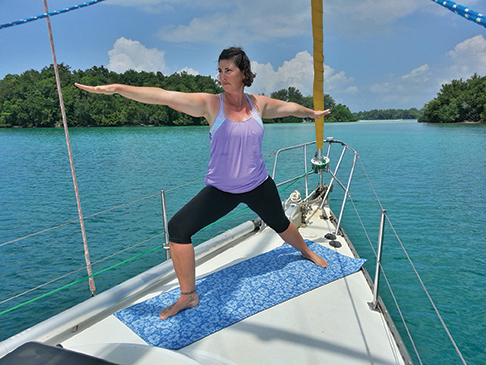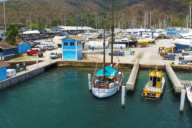Previously published in BWS by Heather Francis.
Sailing is a physical lifestyle. From raising sails and grinding winches to dragging the dinghy up a beach, to schlepping provisions and climbing onboard, every aspect of life on a boat requires a certain level of physical fitness. Underway, taking a few steps can involve more physical dexterity than normal and sometimes even sleeping seems like a full-body workout instead of a restful act—the constant bracing, shifting and compensating for the movement of the boat.
But like the tide, the pace of life on board ebbs and flows. When the long passages of the season are complete, the weekly fun races are finished and the crowds of constant companions that kept you busy have sailed on, it can sometimes feel like activity drops to all-time lows. This happened recently on Kate while we sat out the South Pacific cyclone season in the Solomon Islands.
As the weeks wore on not only was I starting to feel a little bit sluggish but there was also a lingering feeling of restlessness that I just couldn’t shake. So, I returned to a routine that I have been cultivating for over 15 years; I rolled out my mat and got back into yoga.
When most people hear the word “yoga” they immediately picture the stereotypical images of a skinny girl looking serene as she contorts into a pretzel-like pose, or the hippie dude with dreadlocks and baggy pants with a yin-yang tattoo. Originating in India several thousand years ago, the modern yoga practice is made up of a series of poses, or asanas where one arranges the body in positions that encourage awareness, relaxation, balance and concentration. These asanas do provide a physical challenge, and in certain variations yoga is practiced almost purely for physical exercise. However, the root of yoga is holistic in philosophy, with an emphasis on specific breathing techniques and mindfulness of the mind-body connection.
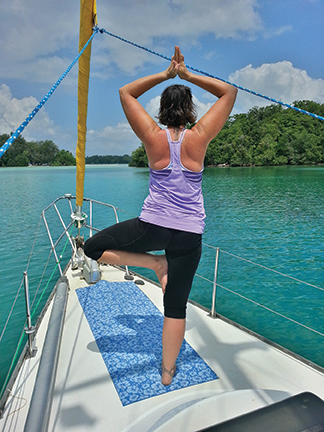
At first glance, yoga and yachts might not seem like a perfect pairing, after all, many yoga poses demand stillness and balance, two conditions not always attributed to life on boats. But yoga also asks that you find a sense of calm and awareness, virtues that will benefit not only those slower days onboard when the cabin fever kicks in but also when things get hectic and stress levels start to climb.
In fact, yoga and sailing have many things in common. Every day out on the water is different, and you have to adapt and adjust to varying winds and seas. Similarly, each day on your yoga mat is different—you have to change and alter poses depending on your mind and body state that day. When sailing you have to yield to universal forces greater than yourself, in yoga you have to accept things as they come and learn from them. In recent years, yoga, like boating, has become fashionable with big-ticket brand names and trendy accessories. In both cases you reap the benefits not when you look the part but when you act the part.
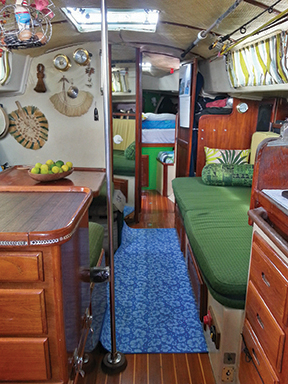
Yoga is also quite complementary to sailing—requiring minimal equipment, a plus when space on board is usually at a premium. All you need to start practicing yoga is a non-skid mat and clothing that is both comfortable and that you can move effortlessly in. Twenty dollars will buy you a good starter yoga mat and, like many things on board, it can do double duty, providing traction underfoot while underway. Yoga also has many positive effects including improving strength, flexibility and balance; three things that any sailor will benefit from by refining. And all of the poses, or asanas, can be modified to suit both your abilities and the conditions in the anchorage. This means you can do yoga virtually anywhere, anytime and that everyone from junior sailors to old salts can participate and benefit.
There is a wealth of information, magazines and videos online concerning yoga but I think the best way to get a proper introduction is by attending a class with a qualified instructor. A good instructor will not only demonstrate how to assume the poses properly but should correct your posture, give advice and answer any questions or concerns you may have. Recently, yoga instructor schools have popped up all over the globe with more and more people devoting the 200-500 hours needed to achieve their instructor rating, so chances are someone in your anchorage is qualified to teach. Check local radio nets to find out if there is a trained instructor in the fleet, most are keen to lead a group class or give private instruction. If you are already practicing yoga this is also a good way to connect with other people in your sailing area.
If you’re moored in an urban center you’re likely to find a yoga studio ashore. I attended a great yoga class in Port Vila, Vanuatu that had a drop-in fee of five dollars and even rented mats. Another great resource are the resorts and marinas in the places that you sail to. These days it is common for hotels to offer yoga classes to guests and most welcome visitors to join in. And even if you have been practicing yoga for years, classes are a great way to learn new skills, break bad habits and to find a little inspiration. Once you’ve learn the basics it is time to move your yoga onboard.
Some people might think that you need a large boat in order to practice yoga on board, or that a monohull isn’t stable enough. Sure, the spacious cockpit of a catamaran would be nice to work in but if you have enough space to roll out your mat then you can practice yoga. When I do yoga in the main cabin of our boat, I take up almost all the floor space and completely block the thoroughfare. It’s a tight fit for about an hour, but it works. On days when it is not blistering hot, and we have a little privacy in the anchorage, I use the foredeck, wedging myself between the cabin top and the windlass. Yoga teaches acceptance, so I acknowledge that my space isn’t perfect but I practice yoga anyway.
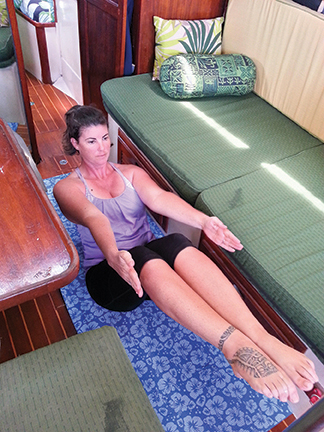
In anchorages that are particularly calm, I can do an extensive yoga session that incorporates sequences with several standing and balancing asanas. When the boat is moving enough to keep me on both feet I switch to more stable poses that often involve having both feet and hands on the mat. And when the harbor is churned up with dinghy wake and the boat is moving in unexpected ways I practice positions that only require me to be seated or lying down. Sometimes I have to modify a pose due to space restriction or conditions in the anchorage that day, but that’s OK because as they say in yoga, there is no “perfect pose”.
To benefit from yoga you do not have to be a certain age, look a certain way or believe in a certain deity, you just have to get on your mat, be present and practice! Part exercise, part stretching, part meditation, yoga engages the mind and body leaving you feeling calm yet invigorated. With minimal equipment and almost infinite variations of poses, yoga is a great way to keep fit and centered while sailing.
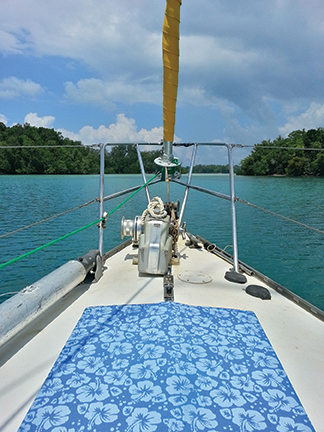 Videos are a great way to keep your yoga routine going. Downloading different styles and levels of yoga onto your phone or device will give you the opportunity to try new things and keep your yoga routine fresh.
Videos are a great way to keep your yoga routine going. Downloading different styles and levels of yoga onto your phone or device will give you the opportunity to try new things and keep your yoga routine fresh.
Some people like to practice first thing in the morning, setting the tone for the day ahead. I prefer to practice in the afternoon, letting the stress and distractions of the day dissolve as I move through various poses. Find a time that works with your schedule onboard and make yoga a part of your every day.
Yoga mats come in various styles, from thick and cushy to ultra-thin and foldable. If you practice in the tropics and sweat a lot you can layer a quick absorb yoga towel over your mat to prevent slipping, or try a pair of yoga socks and mitts.
Heather Francis is originally from Nova Scotia, Canada but has lived and worked on the ocean for over a decade. She has cooked professionally on land and on boats. These days you’ll find her in the galley of Kate, the 41 foot sloop she and her Aussie partner Steve have been sailing since 2008. For more stories, photos and recipes log onto www.yachtkate.com.
FIVE FAVORITES
There are dozens of yoga asanas, or poses, of varying intensity and
skill levels. Here are my five favorites for practicing onboard.
Calm Conditions
Sun Salutation (Surya Namaskar): A classic, sequence of asanas that links
movement with breath, combining standing, forward bend, plank, cobra
and downward dog. Also good for Moderate Conditions.
Standing Forward Bend (Uttanasana): A great beginning pose that
stretches legs and back.
Tree Pose (Vriksasana): A balancing pose with several variations and
levels of difficulty.
Warrior: (Virabhadrasana) Warrior has three variations and is a pose
that works the full body; legs, core and arms.
Triangle Pose (Trikonasana): Standing stretch and balance pose.
Moderate Conditions
Chair Pose: (Utkatasana) Works legs, bum, core and arms.
Plank (Uttihita Chaturanga Dandasana): Great ab work out, can be
modified for more of a challenge as you progress.
Boat Pose (Navasana): A balance pose that works the core—also,
very appropriate for onboard practice.
Cat & Cow (Marjaryasana & Bitilasana): Performed on all fours this
stretches and releases the whole back.
Seated Twist (Ardha Matsyendrasana): A balance and stretching pose.
Choppy Conditions
Seated Forward Bend (Paschimottanasana): Stretches legs and lower back.
Childs Pose (Balasana): A gentle but firm stretch for the lower back.
Bound Angle Pose (Baddha Konasana): Stretch for legs and back.
Reclining Twist (Supta Matsyendrasana): A great stretch for the lower back
and buttocks.
Corpse Pose (Savasana): Traditional performed last, this is a calm and
relaxing pose.

